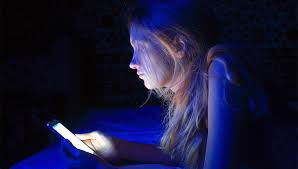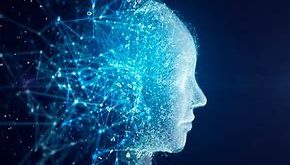The light emitted from our LED screens is blamed for everything from bleary eyes to much more serious health issues. So just how worried should we be?
Long attached to visions of clear skies and calm seas, the colour blue historically could not be more welcome, refreshing and natural. Yet, because of the proliferation of blue-emitting LEDs in our artificially lit lives, blue light has come to represent bleary eyes, sleeplessness and the poor health associated with disruption of the circadian rhythm.
Of the spectrum of lightwaves emitted by the sun that our eyes can detect, it is the shorter “blue” ones that get reflected and bounced around most by the molecules in the Earth’s atmosphere. They are the reason the sky is blue. So why is blue light apparently so bad for us? Earlier this month, a study published in The Lancet Psychiatry looked at data from 91,105 middle-aged people and found that those with disrupted sleep patterns were more likely to have depression or bipolar disorder. The worst affected were described by one of the authors of the paper, Professor Daniel Smith at the University of Glasgow, as those with “very poor sleep hygiene – people on their mobile phones at midnight checking Facebook or getting up to make a cup of tea in the middle of the night”. He reiterated the now common advice from sleep experts: switch off electronic devices an hour before bedtime.
In March, the chief medical officer, Sally Davies, advised caution in using devices emitting blue light while more research is done into its potential harm. Then in April researchers at the Barcelona Institute of Global Health linked increased risks of breast and prostate cancers to blue light exposure at night (an association was found, but whether the light exposure caused the cancers through circadian disruption is unknown). What we do know is that undimmed LED screens and lamps give off more blue light than traditional light sources such as incandescent lightbulbs. And we are using backlit devices more than ever, whether checking social media and bank balances or grappling with heavy workloads, right up until lights out.
The reason manufacturers have switched to brighter LED lights is efficiency. With traditional incandescent lightbulbs, says John O’Hagan of Public Health England’s centre for radiation, chemical and environmental hazards, “95% of what was produced was heat, and only 5% was light.” As well as staying cooler, LED screens have the added benefit of being thinner, lighter and longer lasting, with stunning colour resolution.
One indication of nagging worries about blue light is the increasing availability of anti-blue-light products – including beauty treatments claiming to protect skin from the light from phones and laptops, and anti-blue light lenses. In lab experiments, high exposure to blue light has been shown to damage animal retinas, but there’s no evidence that current levels of exposure are harming humans’ eyes. “The hype around the blue light hazard has got a bit out of control,” says O’Hagan. An advert by Boots Opticians claiming that blue-light filtering lenses could protect consumers from retinal damage, eye strain and fatigue was banned by the Advertising Standards Authority in 2015. When researchers test the blue-light levels in devices, says O’Hagan, “they don’t come anywhere near the international exposure limits even for prolonged viewing, and are only a fraction of what you’d get just walking outdoors on a cloudy day.” Working on his laptop, he says, is “trivial compared to me walking outside and looking up at the sky – not at the sun, just the sky.” If humans were damaged by blue light exposure per se, we would have known about it long before LED screens dominated our lives. “There’s still an awful lot that we don’t know about this,” he concedes, “but I’m fairly convinced blue light is not causing any injuries as such.”
It is blue light’s role in governing circadian rhythms that poses greater concern for public health. “If you go back in time,” says O’Hagan, “as soon as the sun went down you went to bed, and got back up again when the sun came up. It isn’t natural to extend your day with artificial lighting. People are also doing activities in the evenings they wouldn’t have done even 20 or 30 years ago and that stimulation may be having far more effect than the light itself.”
Not that long ago, he says, “your television was a relatively small device in the corner of the room. Now you’ve got a TV completely filling the wall; you are immersed in it. We don’t know what the impact of that is and maybe it’s not a problem at all. But we need some research doing on it.”
“Blue light is not sinister,” says Stuart Peirson, of the sleep and circadian neuroscience institution (SCNi) at Oxford University. “You get changes particularly in the blue part of the spectrum around dawn and dusk and so our bodies have evolved to be able to detect these changes, because they are what’s important for setting our clocks. It’s just that we’ve subsequently invented devices that emit light and we’ve filled our environment with them and made them addictive. If you go to bed at night and stare at your bedside lamp for 10 minutes, that will shift your clock, it’s just that nobody does that.”
The focus on blue light began, he says, “over 15 years ago, when we discovered there is a type of photoreceptor in the eye that detects light, but for circadian responses rather than visual responses.” These include, he says, “setting the circadian clock, regulating sleep and alertness, and also things like hormone responses such as melatonin.” So as well as our visual photoreceptors, known as rods and cones (rods for night sight and cones for bright light and colour vision), we also have photosensitive retinal ganglion cells for circadian responses, and these are particularly sensitive to blue light.
“But what we’ve subsequently learned is that the rods and cones [which are sensitive to a spectrum of light frequencies] also help regulate the circadian responses, while the photosensitive retinal ganglion cells also work as light metres. The photosensitive retinal ganglion cells don’t exclusively absorb blue light, it’s just that they are better at absorbing it than, say, red light. If you cut out blue light, says Peirson, “you’re still getting activation of the circadian system, albeit less.”
A cleverer way to tackle the problem, if you’re not prepared to lower the house lights and give devices a miss towards bedtime, “is to change the colour temperature of the display – how warm or cool it looks.” Frustratingly, the only study Peirson knows of into the efficacy of doing this, using software called f.lux, was inconclusive. “But in fact just dimming the brightness will make a difference,” says Peirson. “The night mode that many devices offer makes the display dimmer. Even if you don’t have night mode, dimming LED lighting by 50% would be less bright to those ganglion cells than a fluorescent or incandescent light.”
Peirson is taken with an idea mooted by a colleague of his from Harvard, that in many ways, light is like a drug. “It can be used for both beneficial and harmful purposes. The key point is knowing when we need it and in what dose.”
Is blue light also the reason we get eye strain or tired eyes after prolonged computer use? John Lawrenson, a professor of clinical visual science at City University of London, isn’t convinced. In a review of robust studies into blue light-blocking lenses, he found “very little in terms of significant differences in satisfaction with blue light-blocking lenses and standard lenses.” This is partly because the lenses can only block a fraction of the blue light, but also, he says, the new term “digital eye strain” can have many components to it – wearing the wrong glasses, dry eyes, or just sitting in front of the computer too long.
Children’s eyes are more sensitive to blue light, because, says O’Hagan, “as we age our blue light vision decreases. By the time you get to about 20 your blue light vision is rubbish.” Overall, however, most people are not affected by any of these issues. “Some people are, know they are and therefore should probably be switching devices off at least an hour before they want to go to sleep. It may have nothing to do with blue light. It’s just light, staring at it and keeping stimulated. For those who do have problems, did they have problems before? Are they particularly sensitive to the light? We don’t know.”
And of course eyes differ, as do circadian rhythms; there are not only larks and owls, but an entire spectrum in between. “The best thing people should do,” he says, “is get out at lunchtime. There’s a lot of evidence that the light you get in the evening is less important than the dose of bright light you got at lunchtime. And it gives you exercise and makes you feel better.” And while the internet is extremely useful, “it’s important for people to stop and do nothing for a while. If you want good sleep, you need to prepare for sleep.”
The Guardian
 Lebanese Ministry of Information
Lebanese Ministry of Information



